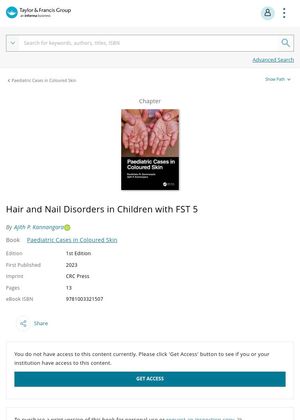TLDR Children with darker skin can have various hair and nail issues.
The chapter reviews 11 common hair and nail disorders in children with Fitzpatrick skin type V (FST 5), using clinical photographs and a question-and-answer format. The conditions discussed include acute paronychia, alopecia areata, anagen effluvium, Beau’s line, frictional alopecia, onychomadesis, longitudinal melanonychia, nail lichen planus, pincer nail (trumpet nail), telogen effluvium, and trichotillosis (hair pulling disorder).
 7 citations
,
December 2008 in “Expert Review of Dermatology”
7 citations
,
December 2008 in “Expert Review of Dermatology” The document concludes that various childhood hair and nail disorders exist, some may improve on their own, and advances in genetics and immunology could enhance treatment and counseling.
 1 citations
,
November 2014
1 citations
,
November 2014 The document explains hair and nail biology, common hair loss conditions and treatments, oral and genital skin diseases, and the risks and treatments associated with squamous cell carcinoma.
 21 citations
,
January 2005 in “Skinmed”
21 citations
,
January 2005 in “Skinmed” Hair and nails are similar keratin structures with different shapes and growth, affected by the same diseases and environmental factors.
 43 citations
,
November 2007 in “Dermatologic Clinics”
43 citations
,
November 2007 in “Dermatologic Clinics” Hair and nail changes can indicate health issues, including cancer and side effects from cancer treatments.
 7 citations
,
May 2014 in “Clinical practice”
7 citations
,
May 2014 in “Clinical practice” Cooling the scalp may prevent hair loss from chemotherapy, hair often grows back after treatment, and nail issues usually improve after stopping the drug.





